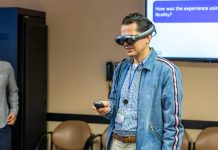
I can’t speak for everyone, but I’ve personally sat through more than my fair share of dry sustainability PowerPoints and videos. And despite being a passionate supporter of the need for Net Zero, it is easy to feel disengaged when looking at that type of content.
This raises an interesting conundrum for all learning and development (L&D) managers: if someone in sustainability training feels that content doesn’t land, what does that say about the chances of less-committed learners engaging with that content?
We’ve spent a lot of time and effort these past few years in corporate training on getting people out of the training room and sitting in rows in front of PowerPoint. That was worth doing, and we’ve opened up a lot of great tools and technologies, playing with gamification, quizzes, bite-sized microlearning, and more to try and increase engagement and, ultimately, learning.
Mother nature – cringe or hilarious?
What I think people need to do is spend time on the actual content and how that content, as content, is served. Take last year’s high production-value ‘2030 Status’ Apple YouTube video, popularly dubbed ‘Apple Mother Nature.’
Though some labeled it ‘cringe,’ and others called out the brand’s tone-deaf inclusion of new product in what was ostensibly CSR marketing, the idea of a mockumentary business meet between the Planet and Apple leadership also earned praise for its use of humor to get its point across.
Of course, not everyone can afford the services of an Oscar-winning Hollywood actor, which goes a long way to generating base levels of interest. But this was genuinely funny. Or at least, funny enough to enough of the audience. It was also moving (“This is my third corporate responsibility gig today, so who wants to disappoint me first?”).
So, is the answer to reframing corporate training to make videos as funny as possible? A lot of HR professionals will exhale slowly at that idea. Isn’t humor notoriously hard to get right? Isn’t it all a minefield, and someone will get offended? It’s best to play safe, right?
Video content – longer the new thing
In my experience of working to deliver sustainability transition training to major global B2Bs and B2Cs, a light-hearted tone can make content much more accessible if it’s done well. Raising a laugh or two can help engage employees around sustainability in a different way, specifically those who are harder to reach.
That’s because learners are so used to video content now that it’s lost its initial impact and novelty value, so we need to amp it up a little. Plus, not everyone has the patience (or the actual time in their day-to-day) to sit through a longer video, so providing valuable data in short chunks that amuse and intrigue is a powerful way to engage.
We’re finding that to be the case for a new programme we launched last year called ‘Climate Brief,’ where we asked our content team to come up with a different spin on some very serious topics: climate change, biodiversity, and how to face down eco-anxiety.
Obviously, given the subject matter, we weren’t aiming for laugh a minute. It’s more about highlighting the human side of the problems, acknowledging them, and folding them into the discourse.
The forgotten legacy of humor in training
In all honesty, using humor in training isn’t reinventing the wheel. In the 1970s in the UK, John Cleese, fresh out of Monty Python, lent his skills to making many business life lessons accessible. If you look for it, there is a forgotten heritage of deft use of small-c ‘comedy’ in L&D content that we might look to revive.
But only for some things. One of the reasons why a CSR report is perceived as “boring” is that it needs to offer data and must be precise with numbers, footnotes, percentages, and more. Stakeholders need to see what progress has been made against targets. Otherwise, the numbers lack context and are meaningless.
By that token, I’d say that perhaps 80 percent of L&D content still needs to be informationally-dense and based on data and logic. But the other 20 percent doesn’t have to be. Raising a few smiles – even in something as serious as sustainability training – and showing your human side can make a connection that may otherwise be missed.



